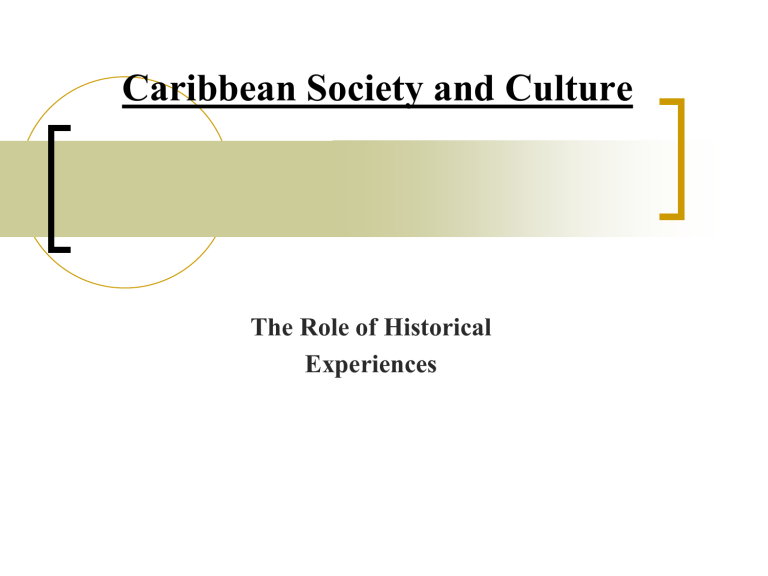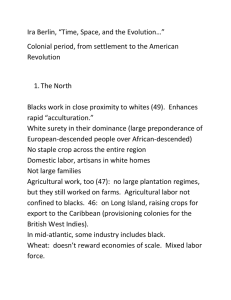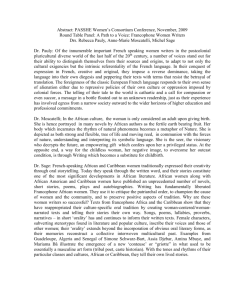
Caribbean Society and Culture The Role of Historical Experiences Influences Experiences with Plantation Slavery - (Europe, Africa, Caribbean) Experiences with Indentureship Colonialism Indigenous Populations The Result Caribbean culture is a rich amalgam of European, African, East Indian, Asian, Plantation, Colonial and Indigenous influences, heritages and cultures Caribbean Theorizing - Creole (process of interculturation), Plural (mixing but not combining), Plantation Society (dependent economies; enclaves of Metropole) Manifestations of Influences Language, Street names, Parishes Music, Games, Sport (cricket, football) Religion System of Social Stratification & Population Structure Food Legal/judicial, Political & Educational Systems Economic Arrangements Other Legacies of Plantation & Colonial Heritages Economic Structure Dependence on metropole Economies adjuncts of metropolitan economies Producers of primary products/raw materials Heavy dependence on imports (debt) Maintenance of preferential trading arrangements (bananas, sugar) Likeness for things foreign Other Legacies of Plantation & Colonial Heritages (cont’d.) Treatment of Class, Race, Colour Light complexion, European physical features & beauty Notions of ‘good’ and ‘bad’ hair Pride of Caribbean Identity Music & Festivals Rastafarianism Language W.I. Cricket Team (Chanderpaul, Lara, Powell, etc.) Resistance to Colonialism & Eurocentrism Rastafarianism Garveyism Black Nationalism Retention of Cultural forms of Countries of Origin Creolization The problem of identity has always been an issue in the modern Caribbean. One of the earliest lines of cleavage was that between whites and mixed elements (creoles). Rivalry was succeeded between Afro-creoles and indentured workers (TT, Guyana and Suriname) (Selwyn Ryan, 2002: JACAS Symposium Series 15) Creolization The term has varying meanings in the Caribbean. Stuart Hall (1977: 164) states “ the term itself is hard to define, it’s ambiguity being itself an index of its complex articulation with the structured form of the cultures and groups with which it interacts.” Lowenthal (1972: 32-33) The term was originally used to define African slaves born in the new world. Later extended to “…anyone, black or white, born in the West Indies…then extended to things, habits and ideas…opinions expressed” Creolization Nettleford (1997: 74) Whites born in the American colonies were regarded as “creoles” by their metropolitan cousins. Jamaican born slaves were similarly differentiated from their “salt-water negro” colleagues freshly brought in from West Africa. Genuine Caribbean expressions are regarded as those that have been “creolized” into indigenous form and purpose distinctively different from the original elements from which those expressions first sprang. Creolization Brathwaite (1974) Creolization is the process through which the various groups in the Caribbean society absorb each other’s cultural products. The Africans and Indians imitated or were forced to imitate the Europeans. Europeans inadvertently but at times consciously absorbed some of the cultural styles, languages and mores of the subordinate groups. Creolization The Africans and Indians acculturated while the European’s process was defined as interculturation. The former is the result of the yoking of cultures by force and example while the latter is an unplanned, unconscious and osmotic relationship following from the yoking process. African Retention One of the main proponents of the African retention school is Melville Herskovits Slavery did not totally destroy the African culture African culture has survived in various forms in the Caribbean African Retention African cultural forms survived in three main ways: 1. Survivals- cultural forms that closely resemble the original African forms. For example, the practice of burying the umbilical chord of a child and planting a fruit tree over it African Retention 2. Syncretisms- the practice of identifying elements in the new culture with parallel components of the old. An example is the practice of identifying Catholic saints with African deities 3. Reinterpretations- This is seen where African culture is reinterpreted to suite the new environment. An example of this is the reinterpretations of African polygamy as progressive monogamy.




